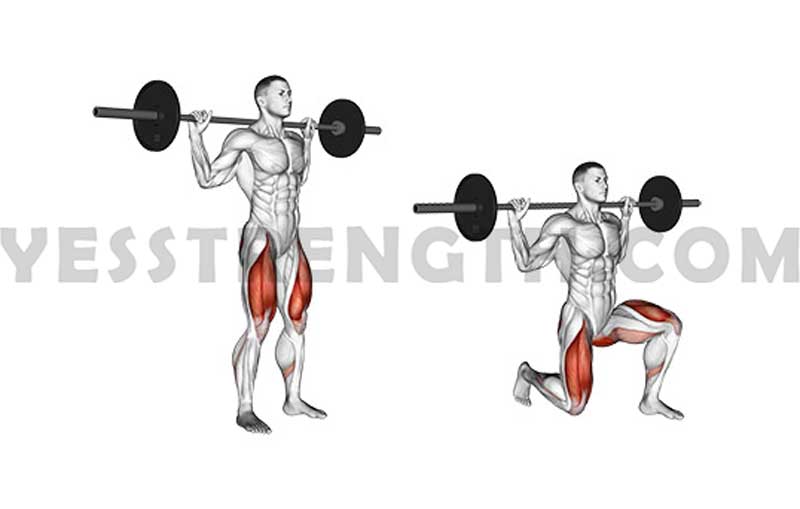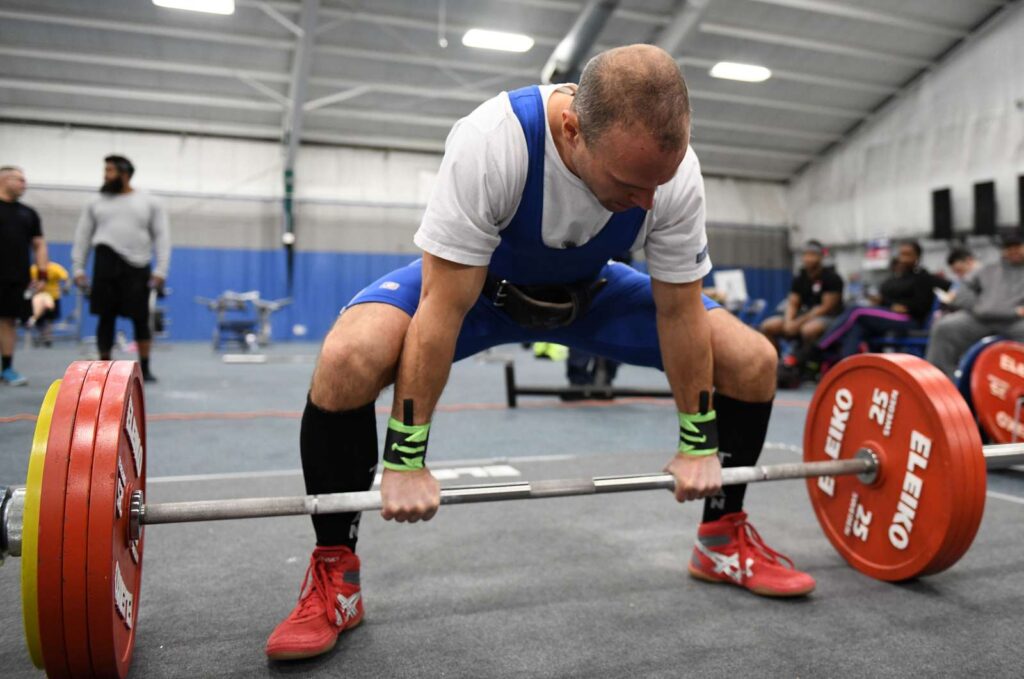Already know about lunges? And want a more challenging lunges exercise that can burn those leg muscles so it helps in more growth and strength? Barbell walking lunges might be just what you need.
This compound movement targets multiple muscle groups in your lower body, helping you build strength, stability, and improve your overall athleticism.
In this article, we will guide you through the proper form and technique for performing barbell walking lunges to maximize your results.
What are Barbell Walking Lunges?
Barbell walking lunges are a dynamic exercise that engages various muscles in your lower body, including your quadriceps, hamstrings, glutes, and calves.
It is a variation of lunge where you walk instead of being stationary while doing it. Also, you carry a barbell on your shoulders.
By adding resistance to the movement with a barbell, you increase the intensity and challenge your muscles even further.
This exercise not only helps build strength and muscle mass but also improves your balance, coordination, and functional movement patterns.
Benefits of Barbell Walking Lunges
Barbell walking lunges offer numerous benefits for individuals of all fitness levels. Here are some key advantages:
1) Strength and Muscle Development
Barbell walking lunges are a compound exercise that engages multiple muscle groups simultaneously, including the quadriceps, hamstrings, glutes, and calves.
This comprehensive activation of major lower body muscles helps in building overall leg strength and muscle development.
By adding resistance with a barbell, you can progressively challenge your muscles and promote growth and hypertrophy.
2) Improved Balance and Stability
Performing barbell walking lunges requires maintaining balance and stability throughout the exercise.
The act of walking while lunging challenges your core muscles and stabilizers, enhancing your overall balance and stability.
This translates into improved coordination and functional movement patterns in everyday activities and sports.
3) Functional Movement
Barbell walking lunges mimic natural movements like walking or climbing stairs, making them highly functional exercises.
By incorporating them into your routine, you improve your ability to perform daily activities with ease and efficiency.
Strong and coordinated lower body muscles contribute to better mobility and functional strength, enhancing your overall quality of life.
4) Calorie Burn and Fat Loss
This leg exercise is a compound exercise that engages large muscle groups, leading to increased calorie expenditure.
The more muscles involved, the higher the metabolic demand. This can contribute to calorie burn during the exercise itself and even after your workout session, supporting fat loss and weight management goals.
5) Core Activation
Maintaining proper form during barbell walking lunges requires engaging your core muscles to stabilize your body.
Your abdominal muscles, lower back, and obliques work together to keep your torso upright and maintain balance.
The consistent activation of your core muscles during this exercise can lead to improved core strength, stability, and aesthetics.
6) Athletic Performance Enhancement
Barbell walking lunge is a dynamic exercise that mimics movements required in various sports, such as running, jumping, or changing directions.
By incorporating this exercise into your training routine, you can enhance your lower body strength, power, and coordination, which are essential for optimal athletic performance.
7) Joint and Bone Health
Weight-bearing exercises like barbell walking lunges help promote joint and bone health.
By placing controlled stress on your joints, such as knees and hips, you stimulate the production of new bone tissue and increase joint stability.
This can aid in preventing conditions like osteoporosis and maintaining healthy joints as you age.
8) Versatility and Progression
Barbell walking lunges can be modified and progressed to match different fitness levels and goals.
You can adjust the weight, vary the step length, incorporate variations like reverse lunges or walking lunges with different equipment (e.g., dumbbells or a weighted vest), or increase the speed and intensity of your lunges.
This versatility allows for ongoing challenges and prevents workout plateaus.
9) Mental Focus and Mind-Muscle Connection
Performing barbell walking lunges requires concentration and focus on maintaining proper form, balance, and control.
This can help improve your mind-muscle connection, enhancing the effectiveness of the exercise and developing a stronger connection between your brain and muscles.
Disadvantages of Barbell Walking Lunges
Although barbell walking lunges offer various benefits and are really good leg exercises, there are some cons to it that you should be aware of. Here are some of them.
1) High Impact on Joints
Barbell walking lunges are a weight-bearing exercise that places stress on the knees, ankles, and hips.
Individuals with pre-existing joint issues or injuries may find it uncomfortable or potentially exacerbate their condition. It’s important to listen to your body and consult with a healthcare professional if you have concerns.
2) Requires Equipment and Space
Barbell walking lunges require access to a barbell, weight plates, and enough space to walk with proper form.
If you don’t have access to a well-equipped gym or enough space at home, it can be challenging to perform this exercise effectively.
3) Technical Difficulty
Mastering the correct form and technique for barbell walking lunge can be challenging, especially for beginners. It may take time and practice to coordinate the movements and maintain balance throughout the exercise.
Starting with lighter weights can help overcome this challenge.
4) Muscle Imbalances
Barbell walking lunges primarily target the quadriceps, hamstrings, glutes, and calves.
If you have significant muscle imbalances or weaknesses in these areas, it can put uneven stress on the muscles and potentially lead to further imbalances.
It’s crucial to address any muscle imbalances and work on overall muscle strength and flexibility.
5) Limited Load Capacity
Unlike exercises like squats or deadlifts, barbell walking lunges may have a limited load capacity.
This is because the focus is on maintaining balance and stability while walking, which can restrict the amount of weight you can use.
If your goal is to lift extremely heavy weights, other exercises may be more suitable.
6) Potential for Fatigue and Overexertion
Barbell walking lunges can be physically demanding, especially when performed for extended periods or with heavier weights.
It’s important to listen to your body and avoid overexertion or pushing beyond your limits, as it can increase the risk of injury or excessive fatigue.
Muscles Worked in Barbell Walking Lunges
1) Quadriceps
The quadriceps muscles, located in the front of your thighs, are the primary movers during barbell walking lunges. They are responsible for extending the knee joint as you push off the ground to stand up from the lunge position.
2) Hamstrings
The hamstrings, situated at the back of your thighs, act as synergists during barbell walking lunges. They assist in the movement by flexing the knee joint as you step forward into the lunge position and providing stability during the exercise.
3) Glutes
The gluteal muscles, specifically the gluteus maximus, medius, and minimus, are highly engaged in barbell walking lunges. These muscles are responsible for hip extension, which occurs when you stand up from the lunge position.
4) Calves
The calf muscles, including the gastrocnemius and soleus, are activated during this high impact exercise as they assist in maintaining balance and provide stability during the exercise. They also play a role in ankle flexion as you step forward and push off the ground.
5) Hip Flexors
The hip flexor muscles, such as the iliopsoas and rectus femoris, are involved in the movement of lifting your leg forward into the lunge position. They assist in hip flexion and work in conjunction with the quadriceps.
6) Core Muscles
The core muscles, including the abdominals, obliques, and erector spinae, play a crucial role in stabilizing the torso and maintaining an upright position during barbell walking lunges. They help prevent excessive leaning forward or sideways and provide overall stability throughout the exercise.
7) Stabilizer Muscles
Various muscles surrounding the hip, knee, and ankle joints act as stabilizers during this leg exercise. These muscles, including the adductors, abductors, and muscles of the lower leg, work to maintain proper alignment and balance during the movement.

Equipment Needed for Barbell Walking Lunges
To perform barbell walking lunges, you will need the following equipment:
- Barbell
- Weight plates
- Weightlifting belt (optional)
- Proper footwear
Ensure that you have access to these items before attempting the exercise.
Barbell Walking Lunges – Proper Form and Technique
To execute barbell walking lunges correctly, follow these step-by-step instructions:
1) Set up the Barbell
- Start by setting up a barbell in a rack at about chest height.
- Load the desired weight plates onto the barbell, making sure they are secure.
2) Positioning and Grip
- Stand facing the barbell with your feet shoulder-width apart.
- Bend down and grasp the bar with an overhand grip, slightly wider than shoulder-width apart.
- Lift the barbell off the rack and position it comfortably on your upper back and shoulders, resting across your trapezius muscles.
3) Initiating the Lunge
- Take a step forward with your right foot, extending it out in front of you.
- Lower your body by bending both knees, allowing your back knee to drop toward the ground.
- Keep your torso upright, core engaged, and your gaze forward throughout the movement.
4) Executing the Lunge
- Push through your front heel to drive your body back up to the starting position.
- As you stand up, bring your back foot forward to meet your front foot.
- Repeat the lunge motion with your left leg, stepping forward and lowering down into a lunge.
- Continue alternating legs and walking forward, maintaining a controlled and steady pace.
5) Walking Forward
- Take small steps as you perform each lunge, ensuring stability and control.
- Maintain a smooth and fluid motion as you move forward, focusing on maintaining proper form throughout the exercise.
Common Mistakes to Avoid
While performing barbell walking lunges, it’s important to avoid these common mistakes:
1) Leaning Forward
Leaning forward excessively places unnecessary strain on your lower back and reduces the effectiveness of the exercise. Keep your torso upright and maintain proper alignment throughout the movement.
2) Overstriding
Taking overly long strides can compromise your balance and form. Instead, focus on taking smaller, controlled steps to maintain stability and engage the targeted muscles effectively.
3) Collapsing Knee
Allowing your front knee to collapse inward puts excessive stress on the joint and increases the risk of injury. Keep your knee in line with your toes throughout the lunge motion to protect your knee joint.
Variations and Modifications
Here are a few variations and modifications to spice up your barbell walking lunge:
1) Dumbbell Walking Lunges
Instead of using a barbell, hold a dumbbell in each hand while performing walking lunge each side. This variation adds an extra challenge to your workout and increases the demand on your stabilizing muscles.
2) Weighted Vest Walking Lunges
For advanced exercisers, wearing a weighted vest can intensify the workout. The added resistance challenges your muscles further, helping to build strength and improve endurance.
3) Reverse Walking Lunges
Reverse walking lunges target your muscles differently compared to the traditional forward lunges. Step backward instead of forward, engaging your muscles in a slightly different way.
Incorporating Barbell Walking Lunges into Your Workout Routine
To incorporate this amazing leg exercise into your workout routine, consider the following suggestions:
- Warm up adequately before starting the exercise to prepare your muscles for the workout.
- Perform 2-3 sets of 10-12 repetitions per leg, gradually increasing the weight as you become more comfortable with the movement.
- Include barbell walking lunges in your leg day routine, alternating them with other lower body exercises to achieve a well-rounded workout.
Safety Precautions and Tips
To ensure a safe and effective workout, keep the following safety precautions and tips in mind:
- Start with a lighter weight or no weight at all to master the proper form and technique.
- Engage your core muscles throughout the exercise to maintain stability and protect your lower back.
- Maintain a controlled pace and avoid rushing through the movement.
- If you experience any pain or discomfort, stop the exercise and consult with a healthcare professional.
Conclusion
Barbell walking lunges are an excellent addition to your leg workout routine, providing a range of benefits for strength, stability, and overall athleticism. By following the proper form and technique outlined in this article, you can perform barbell walking lunges safely and effectively.
Remember to start with lighter weights and gradually increase the intensity as you become more comfortable with the exercise. Incorporate variations and modifications to keep your workouts challenging and exciting. Stay consistent, and you’ll see improvements in strength, muscle development, and functional movement.
FAQs
1) Can barbell walking lunges help with fat loss?
Yes, barbell walking lunge is a compound exercise that engages multiple muscle groups, leading to increased calorie burn. When combined with a balanced diet and regular exercise, barbell walking lunges can contribute to fat loss.
It is primarily a strength exercise, so the result can take a long time for fat loss. Having cardio along can fasten the results.
2) How often should I perform barbell walking lunges?
The frequency of barbell walking lunge depends on your fitness goals and current workout routine.
For most individuals, incorporating them into your leg day routine once or twice a week is sufficient. Listen to your body and adjust the frequency as needed.
3) Can beginners perform barbell walking lunges?
Yes, beginners can perform this exercise without any problem. However, it is essential to start with lighter weights or no weight at all to focus on mastering the proper form and technique before adding resistance.
4) Should I wear a weightlifting belt while performing barbell walking lunges?
Wearing a weightlifting belt is a personal preference. If you feel more secure and supported with a weightlifting belt, you can use one.
However, it’s important to note that relying solely on a weightlifting belt for stability is not recommended. Focus on engaging your core muscles and maintaining proper form.
5) Can I perform barbell walking lunges at home?
Barbell walking lunges require the use of a barbell and weight plates, which may not be readily available at home.
However, you can modify the exercise by using dumbbells or other weighted objects to create resistance.
Always ensure that you have enough space and a safe environment to perform the exercise.
And always Say Yes to Strength!





